As Pyongyang Confirms Troops in Russia and Lavrov Rejects Any Territorial Concessions, Trump and Zelensky Meet in Vatican While Battlefield Innovation Accelerates
Summary of the Day – April 27, 2025
The battlefield in Ukraine witnessed Russian forces rapidly adapting to Ukrainian drone dominance by deploying motorcycles and light vehicles—expanding contested zones from two to seven kilometers. North Korea officially confirmed its troops are fighting alongside Russia, while Foreign Minister Lavrov rejected any territorial concessions in peace talks. President Zelensky met with Trump at the Vatican in a “productive” encounter before Trump publicly questioned Putin’s commitment to peace. Ukrainian Prime Minister Shmyhal secured a breakthrough in minerals negotiations, ensuring previous U.S. aid won’t be counted in the agreement. Meanwhile, Ukraine’s air defenses set records, with NASAMS downing 11 Russian cruise missiles in under two minutes during a massive drone assault that struck civilian areas across multiple regions.
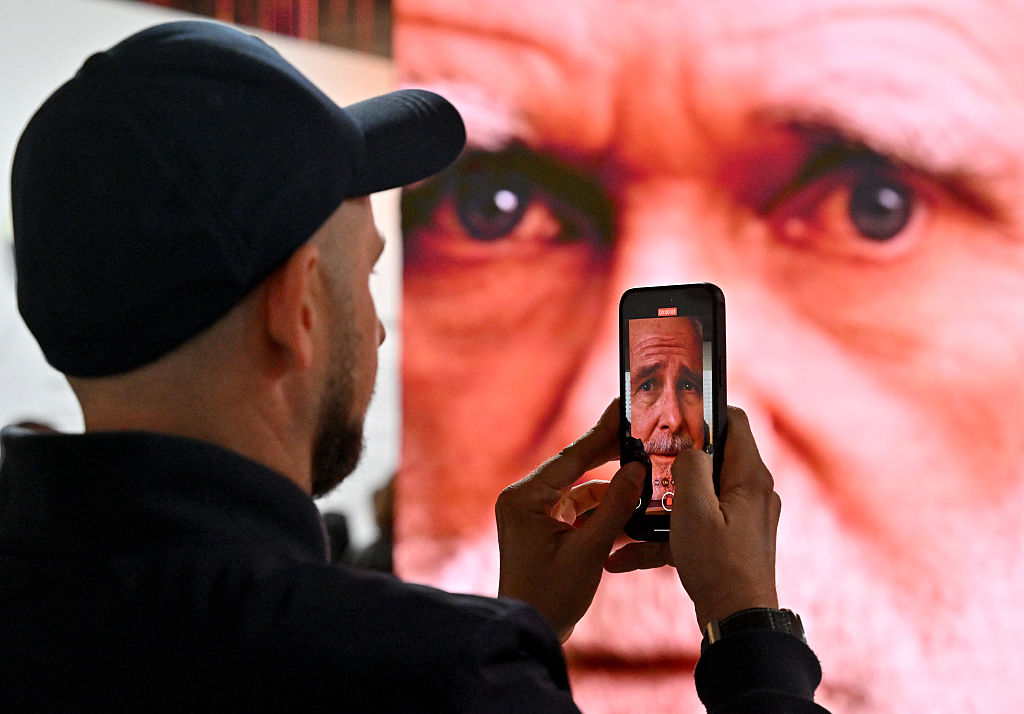
A visitor takes pictures during a visit at the “Third Wind. Emotions and Feelings” interactive exhibition in Kyiv. The exhibition, at the discretion of the organisers, should help visitors to understand their emotions, relieve stress, and find their inner child, amid the Russian invasion in Ukraine. (Sergei Supinsky / AFP via Getty Images)
The Evolving Art of Drone Warfare: How Remote Combat is Rewriting Military Doctrine
The battlefield in Ukraine has undergone a profound transformation, transitioning from traditional ground combat to what Ukrainian military officials now characterize as “long-range, remote combat.” A non-commissioned officer from a Ukrainian unmanned systems battalion operating in the Chasiv Yar direction revealed on April 27 that the contested battlefield’s “gray zones” have expanded dramatically—from 500 meters to two kilometers in 2024 to an astonishing five to seven kilometers today in some frontline sectors.
Ukraine’s military, maintaining over 100 brigades defending a frontline exceeding 2,100 kilometers, has become the testing ground for battlefield innovations that typically would take years to develop but are now deployed in months or even weeks. Both sides race to adapt, with Russian forces mimicking Ukrainian tactics of using drones to intercept enemy UAVs and conduct remote mining operations. The innovations born in this conflict, military analysts note, will likely shape warfare doctrine for decades to come, as remote combat increasingly replaces traditional infantry and armored engagements.
Russia’s Two-Wheeled Adaptation: Motorcycles Emerge as Anti-Drone Tactics
Russian commanders have devised an unexpected answer to Ukraine’s devastating drone capabilities: motorcycles. Ukrainian Khortytsia Group of Forces Spokesperson Colonel Viktor Trehubov reported on April 27 that Russian forces are increasingly deploying on motorcycles and buggies instead of heavy armored vehicles across multiple fronts, particularly in the Kharkiv and Kupyansk directions.
“They can’t drive heavy armor close to our positions anymore,” a Ukrainian servicemember in the Pokrovsk direction explained, noting that Russian forces have conducted 13 motorized assaults on motorcycles since March 20. The speed, small profile, and maneuverability of motorcycles and light civilian vehicles help Russian troops disperse quickly and present more challenging targets for Ukrainian drone operators.
The Russian military appears to be developing a formal tactical doctrine around motorcycle usage, preparing to systematically integrate them into summer and fall offensive operations. This adaptation represents a significant shift in tactics as Russia attempts to offset Ukraine’s technological edge with increased mobility and dispersed formations.
Pyongyang’s Admission: North Korea Confirms Troops Fighting for Russia
North Korea broke its silence on April 27, officially confirming for the first time that it has deployed troops to fight alongside Russian forces in Ukraine. The announcement, reported by state-run KCNA, described the deployment as demonstrating the “highest strategic level of the firm militant friendship” between North Korea and Russia.
The Central Military Commission of the ruling Workers’ Party revealed that leader Kim Jong-un personally authorized the deployment under the comprehensive strategic partnership treaty signed with Russian President Vladimir Putin in 2024. “Under the order of the head of state, the sub-units of the armed forces of the Republic regarded the territory of Russia as the one of their country and proved the firm alliance between the two countries,” the statement declared.
Kim praised the North Korean soldiers as “heroes and representatives of the honor of the motherland,” while KCNA emphasized that North Korea “regards it as an honor to have an alliance with such a powerful state as the Russian Federation.” Ukrainian intelligence estimates suggest North Korea has sent approximately 11,000 troops to Russia, including 3,000 reinforcements to replace battlefield losses.
Lavrov’s Red Line: Russia Categorically Rejects Territorial Concessions
Russian Foreign Minister Sergei Lavrov delivered an uncompromising message regarding territorial concessions in an interview with CBS News aired on April 27, bluntly stating that “Russia does not negotiate its territory” when questioned about the status of Russian-occupied Crimea in ongoing peace negotiations.
Lavrov also dismissed the possibility of transferring control of the Zaporizhzhia Nuclear Power Plant to international management, declaring he doesn’t “think any change is conceivable.” The statement directly contradicts a key element of the Trump administration’s proposed seven-point conflict termination plan, which reportedly includes the transfer of the nuclear facility as one of its terms.
“If not for the Ukrainian regular attempts to attack the station and to create a nuclear disaster for Europe and for Ukraine as well, the safety requirements are fully implemented and it is in very good hands,” Lavrov claimed, reaffirming Moscow’s long-standing position of rejecting any territorial concessions in peace talks.
Minerals Breakthrough: Shmyhal Secures Key Concession in U.S. Negotiations
In a significant development for Ukraine’s economic future, Prime Minister Denys Shmyhal announced on April 27 that the pending minerals agreement between the United States and Ukraine will not count financial aid provided to Kyiv prior to the signing of the deal—a critical victory for the Ukrainian negotiating team.
“The main thing is that we have clearly defined our red lines,” Shmyhal declared in a Telegram post following his meetings with U.S. Treasury Secretary Scott Bessent in Washington. “The agreement must comply with European obligations and not contradict the Constitution and legislation of Ukraine.”
The announcement represents a breakthrough after months of tense negotiations over an agreement that Trump has touted as a way to “recoup” aid provided to Ukraine. “It must be ratified by the Parliament. It has been agreed that the document does not count the assistance provided before its signing,” Shmyhal emphasized, addressing a key concern voiced by Ukrainian officials who had feared the deal could convert previous aid into debt.
Vatican Diplomacy: Trump and Zelensky’s “Productive” Face-to-Face Meeting
President Volodymyr Zelensky and U.S. President Donald Trump held their first in-person meeting since February’s tense White House encounter, coming together in St. Peter’s Basilica on April 27 amid Pope Francis’s funeral ceremonies. Both sides characterized the meeting as “productive” and “constructive.”

US President Donald Trump (L), and Walt Nauta, White House director of Oval Office operations, walk on the South Lawn of the White House after arriving on Marine One in Washington, D.C. (Jim Lo Scalzo/EPA/Bloomberg via Getty Images)
“President Trump and President Zelensky met privately today and had a very productive discussion,” White House communications director Steven Cheung stated, while Presidential Office head Andriy Yermak echoed the positive assessment without providing specifics.
“Good meeting. We discussed a lot one on one. Hoping for results on everything we covered,” Zelensky said afterward. “Protecting lives of our people. Full and unconditional ceasefire. Reliable and lasting peace that will prevent another war from breaking out. Very symbolic meeting that has potential to become historic, if we achieve joint results.”
The encounter marks a potential thaw in relations between the leaders after months of tension, with European officials having pushed for the Vatican meeting to smooth differences and break the deadlock in peace negotiations.
European Solidarity: Leaders Rally Behind Zelensky After Trump Meeting
Following his pivotal meeting with Trump, President Zelensky engaged in a flurry of diplomatic consultations with European leaders at the Vatican on April 27, securing renewed commitments of support for Ukraine’s position in peace negotiations.
“Ukraine is ready for an unconditional ceasefire. President Zelensky reaffirmed it to me today,” French President Emmanuel Macron wrote following their meeting. “It is now up to President Putin to prove that he truly wants peace.” Macron emphasized that France and its partners would continue working through the “coalition of the willing” launched in Paris in March to push for “both a ceasefire and a full, lasting peace in Ukraine.”
Zelensky also met with British Prime Minister Keir Starmer, Italian Prime Minister Giorgia Meloni, and European Commission President Ursula von der Leyen, who reaffirmed Europe’s steadfast support. “Europe will always stand by Ukraine in the pursuit of peace,” von der Leyen stated. “You can count on our support at the negotiating table to achieve a just and lasting peace.”
The unified front presented by European leaders underscored their commitment to ensuring Ukraine’s voice remains central to any peace negotiations, particularly as Trump’s administration pushes for a swift resolution that some fear could favor Russian interests.
Trump’s Direct Appeal: “Stop Shooting and Sign a Deal”
U.S. President Donald Trump issued his most direct public appeal to Russian President Vladimir Putin on April 27, demanding concrete action to end hostilities in Ukraine.
“Well, I want him to stop shooting, sit down and sign a deal,” Trump told reporters when asked about his expectations for Putin. “We have the confines of a deal, I believe, and I want him to sign it and be done with it,” he added, signaling growing impatience as negotiations stall.
Trump expressed disappointment with Russia’s continued military operations, particularly recent missile strikes on Ukrainian cities. “I was very disappointed that missiles were flying, [fired] by Russia,” Trump said, in a notable shift from his typically measured rhetoric toward Moscow.
The president appeared more positive about his meeting with Zelensky, describing the Ukrainian leader as “calmer” and suggesting that “he understands the picture, and I think he wants to make a deal.” This characterization stood in stark contrast to the tense exchanges between the two leaders during their White House meeting in February.
Estonia’s Diplomatic Insight: Karis Reveals Trump’s Ceasefire Commitment
Estonian President Alar Karis provided a rare glimpse into Trump’s private thinking on the peace process, revealing that the U.S. president promised not to withdraw as a mediator in Russia’s war against Ukraine during a conversation at the Vatican on April 27.
Karis told regional media outlet ERR that he spoke directly with Trump following Pope Francis’s funeral, asking about the progress of peace talks. “I asked him how the peace process was going and asked him to do everything to ensure that the process continued, so that the U.S. did not withdraw,” Karis recounted.
According to the Estonian president, Trump assured him that the United States would continue working toward a ceasefire between Ukraine and Russia, saying, “He promised to do so and said that we were quite close to a solution, since he had just met with Zelensky.”
This private assurance comes at a critical moment, as Secretary of State Marco Rubio has publicly suggested the U.S. might shift focus away from Ukraine if significant progress isn’t made in the coming week.
Rubio’s Deadline Warning: “Critical Week” Ahead for Peace Process
U.S. Secretary of State Marco Rubio delivered a stark message on April 27, declaring the upcoming week “critical” in determining whether the United States will continue its involvement in Russia-Ukraine peace efforts or shift focus elsewhere.
“This is going to be a really important week in which we’re going to have to decide whether we want to continue to engage in this effort, or whether it’s time for us to shift our focus to other issues that are just as, if not more, important,” Rubio told NBC, suggesting the Trump administration’s patience for protracted negotiations may be wearing thin.
While declining to set a specific deadline, Rubio emphasized that prospects for a peace agreement are closer than at any time in the past three years but acknowledged that significant obstacles remain. “The president has spent a lot of time and energy on this, and I think we’ve brought the parties closer than they’ve been in a long time, but we’re still not there,” he said, balancing optimism with what he called “realism” about the challenges ahead.
Trump’s Rhetorical Shift: Putin “Maybe Doesn’t Want to Stop the War”
In a striking shift in rhetoric, U.S. President Donald Trump publicly questioned Russian President Vladimir Putin’s commitment to peace negotiations on April 27, suggesting that continued Russian attacks on Ukrainian civilians indicate Moscow may not be negotiating in good faith.
“There was no reason for Putin to be shooting missiles into civilian areas, cities and towns, over the last few days,” Trump wrote in a Truth Social post following his meeting with Zelensky. “It makes me think that maybe he doesn’t want to stop the war, he’s just tapping me along, and has to be dealt with differently, through banking or secondary sanctions?”
The comments represent an unusual public rebuke of Putin from Trump, who has typically directed his criticism at Zelensky while adopting a more conciliatory tone toward the Russian leader. This rhetorical pivot comes as Russia has intensified strikes against civilian areas in Ukraine, including an attack that killed 12 civilians and injured 90 in Kyiv on April 24.
The False Flag Confession: Russian Commander Admits to Geneva Convention Violation
Russian Major General Apti Alaudinov, Deputy Head of the Russian Ministry of Defense’s Main Military-Political Directorate and Akhmat Spetsnaz Commander, openly described battlefield deception tactics on April 27 that experts say likely constitute perfidy—a war crime under the Geneva Convention.
Alaudinov revealed that Russian forces recently used blue electrical tape identification marks during operations in Kursk Oblast, knowing that Ukrainian forces also use blue tape to identify friendly units. “We were supposed to have blue tape for the first 24 hours of the operation and then change it to red [tape],” Alaudinov told TASS, explaining the tactic was designed to “prevent the Ukrainian military from understanding what was happening” and to make them “think that their own units were advancing.”
The Geneva Convention explicitly defines perfidy as “acts inviting the confidence of an adversary to lead him to believe that he is entitled to, or is obliged to accord, protection under the rules of international law applicable in armed conflict, with intent to betray that confidence”—a definition that appears to directly match the Russian commander’s description of his troops’ actions.
Kursk Contradiction: Russian Commander Undermines Kremlin’s Victory Claims
The acting commander of Russia’s 810th Naval Infantry Brigade (Black Sea Fleet) inadvertently contradicted the Kremlin’s official position on April 27, reporting to Russian President Vladimir Putin that Russian forces will destroy all remaining Ukrainian troops in Kursk Oblast “in the near future”—an admission that directly challenges earlier claims that Russian forces had fully recaptured the entire region.
“Our troops continue active defensive operations in designated areas of the Kursk and Belgorod regions,” President Zelensky confirmed the same day, directly refuting Moscow’s assertions. Russian military bloggers added to the confusion, with several reporting that Russian forces continue conducting clearing operations near Gornal and Oleshnya (both southwest of Sudzha), while another noted Russian forces still need to push Ukrainian forces “the last few meters” to the international border.
The contradictory statements reveal the ongoing challenge Russia faces in establishing full control over Kursk Oblast, where Ukrainian forces launched a cross-border incursion in August 2024, marking the first major foreign military operation on Russian soil since World War II.
Border Infiltration: Russian Small Groups Target Sumy Oblast Expansion
Russia continues deploying small assault groups to infiltrate Ukrainian territory in Sumy Oblast to broaden the front line area, State Border Guard spokesperson Andrii Demchenko told Ukrinform on April 27, revealing a tactical approach aimed at gradually expanding the conflict zone along Ukraine’s northern border.
“Recently, we have observed attempts to expand these activities, both within this zone and to other areas, where we periodically detect attempts by these groups to infiltrate,” Demchenko explained, noting that Russian troops are focusing assaults on the border villages of Basivka and Zhuravka while using quad bikes to quickly penetrate deeper into Ukrainian territory, establish footholds, and await reinforcements.
Geolocated footage published on April 27 confirmed Russian forces have recently advanced along the C-191503 highway in northern Loknya (northeast of Sumy City), while Russian military bloggers claimed that elements of the 51st Airborne Regiment had advanced into Sumy Oblast from Oleshnya, Kursk Oblast.
Deadly Strike on Kostiantynivka: Russian Bombs Shatter Civilian Lives
Russian troops launched three airstrikes on Kostiantynivka in Donetsk Oblast on the morning of April 27, killing three civilians and injuring four others in yet another attack targeting residential areas, the Donetsk Oblast Prosecutor’s Office reported.
During the strike around 11 a.m., Russian forces dropped FAB-250 bombs on a residential neighborhood, damaging 21 homes and claiming the lives of a married couple aged 47 and 48, as well as a 78-year-old man. Two women aged 67 and 73, and two men aged 77 and 83 sustained injuries described by prosecutors as “blast injuries, shrapnel wounds, and contusions.”
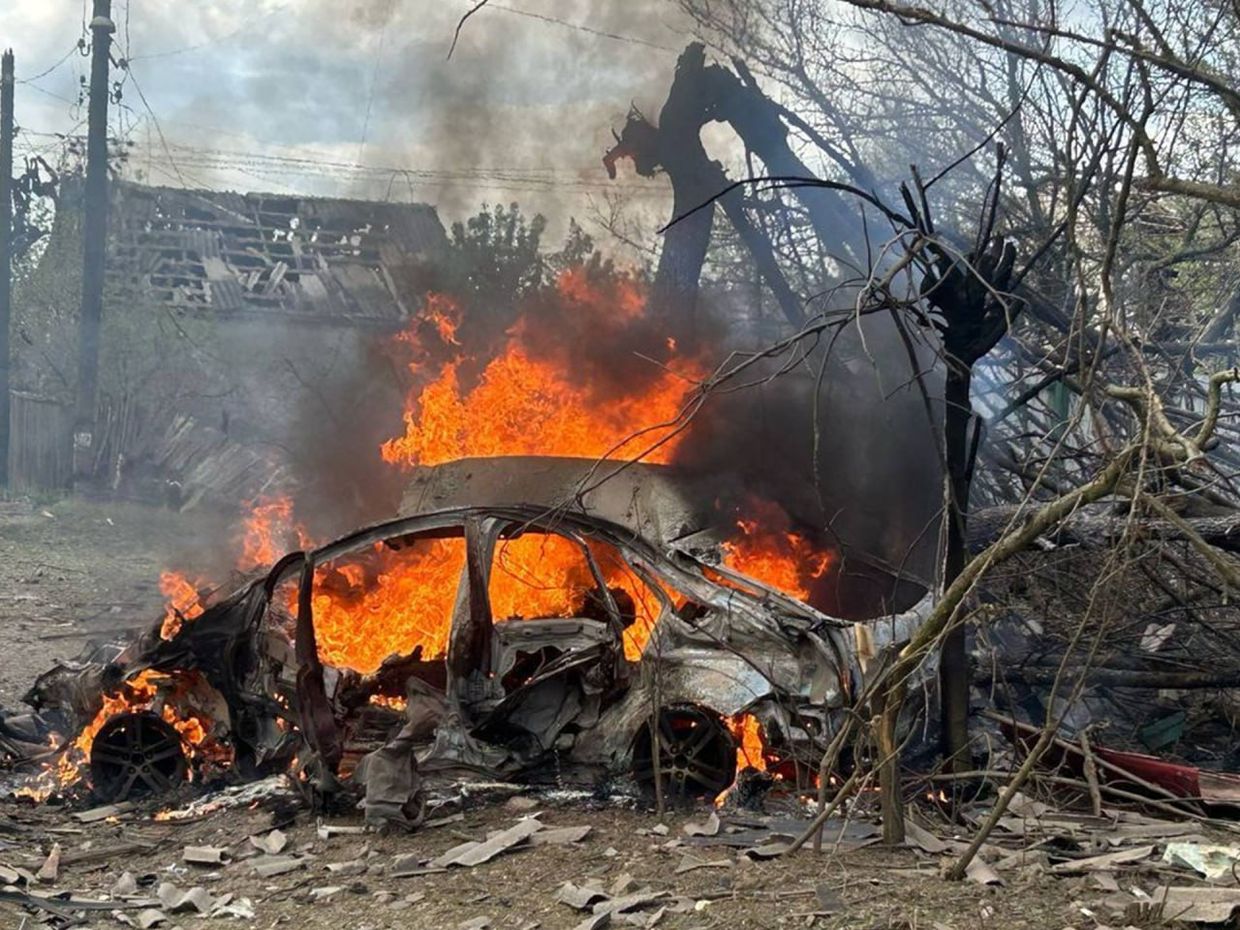
The aftermath of Russian attack on Kostiantynivka in Donetsk Oblast. (Donetsk Oblast Prosecutor’s Office/ Telegram)
Kostiantynivka, located about 10 kilometers southwest of the front-line city of Chasiv Yar and home to around 67,000 people before the war, has been repeatedly targeted by Russian artillery and airstrikes throughout the conflict. The latest attack represents another in the pattern of strikes against civilian targets in Donetsk Oblast.
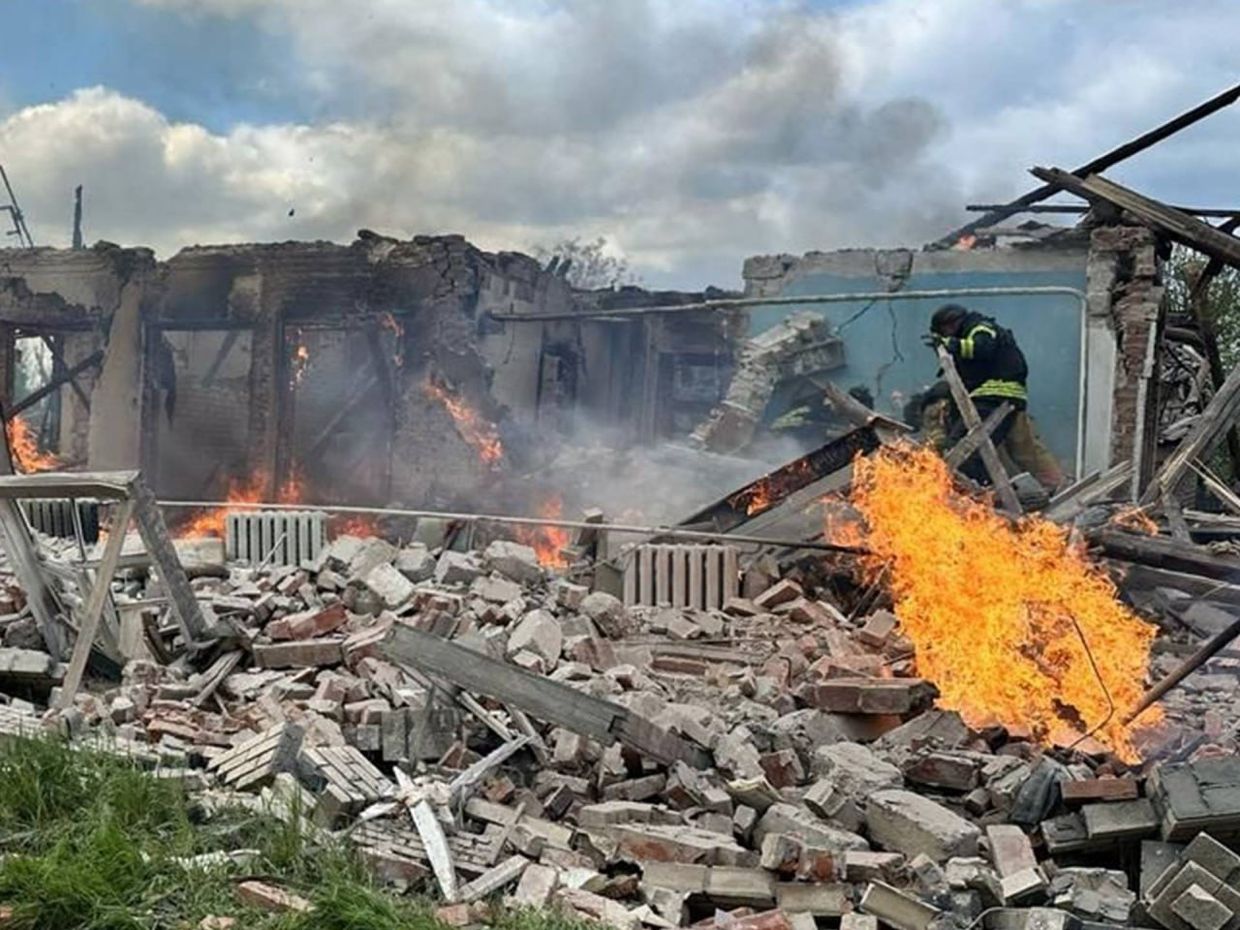
The aftermath of Russian attack on Kostiantynivka in Donetsk Oblast. (Donetsk Oblast Prosecutor’s Office/ Telegram)
The Drone Deluge: Ukraine Repels Massive Russian Air Attack
Ukrainian air defenses faced one of their most challenging nights as Russian forces launched a massive drone assault overnight on April 26-27, sending 149 UAVs toward targets across Ukraine from launch points in Kursk, Bryansk, Oryol, and Primorsko-Akhtarsk in Russia’s Krasnodar Krai.
In a testament to the growing sophistication of Ukraine’s electronic warfare and air defense systems, Ukrainian forces downed 57 drones while another 67 Russian decoy drones were “lost”—likely due to Ukrainian electronic warfare interference that disrupted their guidance systems. Despite these successes, some drones broke through defenses to strike infrastructure in Dnipropetrovsk, Zhytomyr, and Odesa oblasts.

The aftermath of the Russian attack on Dnipropetrovsk Oblast. (Serhii Lysak/Telegram)
The attacks claimed civilian casualties, with a Russian drone strike on Pavlohrad in Dnipropetrovsk Oblast killing one person and injuring a 14-year-old girl while damaging two apartment buildings. In Zhytomyr Oblast, drone strikes damaged at least 15 private homes and hospitalized one civilian, while additional drone attacks injured two people in Sumy Oblast and a 35-year-old woman in Odesa Oblast.
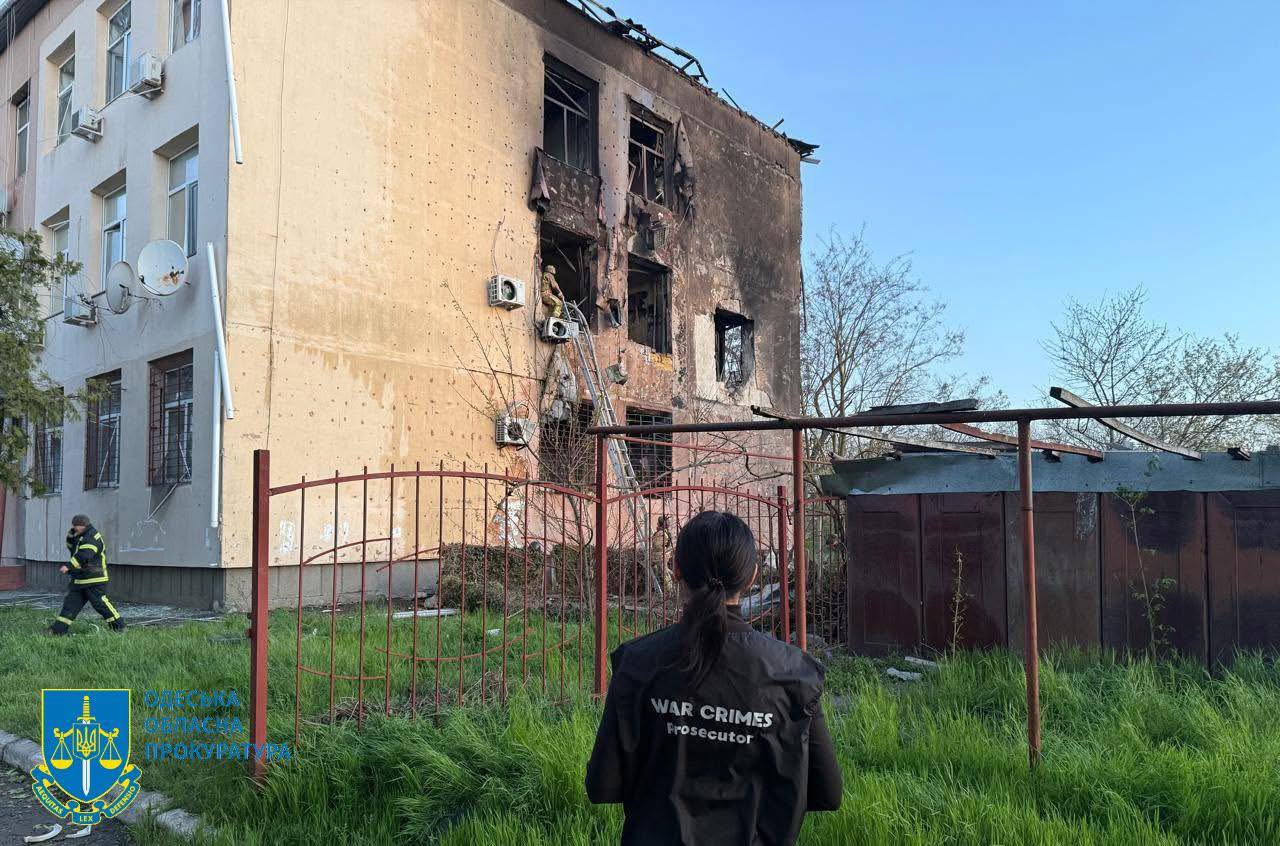
The aftermath of the Russian drone strike on Odesa Oblast. (Odesa Oblast Prosecutor’s Office/Facebook)
Ukraine’s Air Defense Milestone: NASAMS System Sets New Combat Record
Ukrainian forces operating NASAMS air defense systems achieved an unprecedented feat on April 27, downing 11 Russian cruise missiles in less than two minutes—a combat record that showcases the growing expertise of Ukrainian air defense operators even as ammunition supplies remain a critical concern.
“We probably broke all records of other countries for reload speed, and we are ready to keep doing it constantly to defend our country, as long as we have the missiles,” Air Force Lieutenant Colonel Kyrylo Peretyatko announced in a video statement. “In one air defense battle, we shot down 11 cruise missiles. The operation lasted no more than two minutes.”
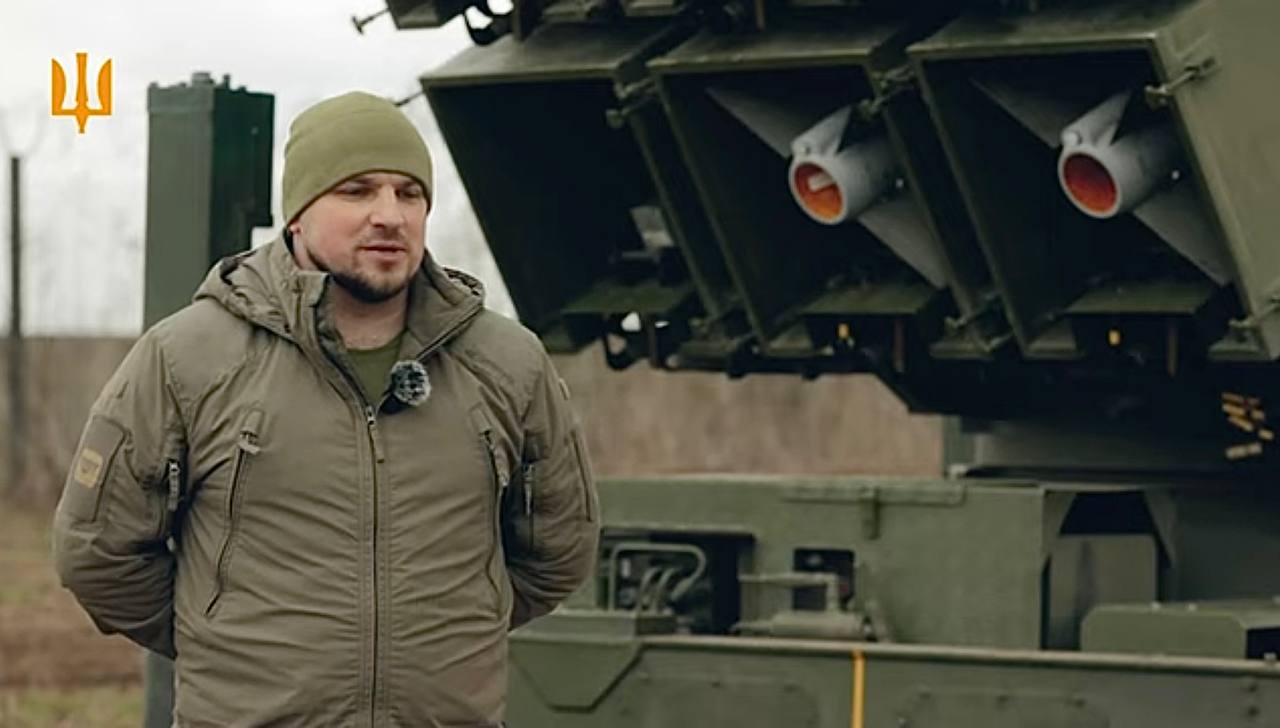
Air Force Lieutenant Colonel Kyrylo Peretyatko (Screenshot from video)
This dramatic demonstration of Ukraine’s air defense capabilities comes as the Ukrainian air force reported downing 442 Russian Shahed kamikaze drones and over 230 other attack drones over the past week, along with 31 Kh-101/Kh-55SM cruise missiles, seven Iskander ballistic missiles, six Kalibr cruise missiles, and four Kh-59/Kh-69 guided air-launched missiles—a testament to both the intensity of Russian strikes and the effectiveness of Ukrainian defenses.
Battlefield Back-and-Forth: Ukrainian and Russian Forces Trade Advances
The dynamic nature of the frontline was evident on April 27, with both Ukrainian and Russian forces securing limited territorial gains in different sectors. Ukrainian forces advanced to the southwestern outskirts of Zahryzove (northeast of Borova), while Russian forces pushed forward in several areas, most notably near Chasiv Yar and Toretsk.
In the Toretsk direction, Russian forces advanced to the railway line in northeastern Shcherbynivka and within central Berezivka, with Russian military bloggers claiming control of additional territory. Fierce fighting continued across multiple fronts, with Russian forces attacking in the Pokrovsk, Novopavlivka, Kurakhove, and Velyka Novosilka directions.
Russian forces also continued offensive operations in western Zaporizhia Oblast, attacking southeast of Orikhiv near Mala Tokmachka and southwest of Orikhiv near Stepove and Mali Shcherbaky, though without confirmed advances. In the Lyman direction, Russian forces launched ground attacks north of Lyman toward Lypove and northeast of Lyman near Novomykhailivka, Nove, Ridkodub, Yampolivka, and Kolodyazi, while operations in the Siversk direction targeted areas northeast of Siversk near Bilohorivka and Hryhorivka.
Moscow’s Manhunt: FSB Claims Capture of Ukrainian “Agent” in General’s Assassination
Russian law enforcement announced on April 27 the arrest of Ignat Kuzin, the man accused of assassinating Lieutenant General Yaroslav Moskalik, deputy head of the Russian General Staff’s Main Operational Directorate, in a car bombing on April 25.
The Russian Investigative Committee and Federal Security Service (FSB) claimed that Kuzin purchased a car and installed the improvised explosive device, which was allegedly detonated remotely by the Ukrainian State Security Service (SBU) from Ukraine. According to Russian media citing Kremlin newswire TASS, Turkish authorities detained and extradited Kuzin to Russia after he attempted to flee from Moscow to Turkey, though no independent confirmation has emerged from Turkish officials.
The incident occurred amid heightened tensions, coinciding with U.S. Special Envoy Steve Witkoff’s arrival in Moscow to meet with Russian President Vladimir Putin. Ukrainian officials have not commented on the assassination as of publication.
Zelensky’s Accusation: Russia “Deceiving” World About Peace Intentions
President Volodymyr Zelensky delivered a blistering indictment of Russia’s peace posturing in his evening address on April 27, accusing Moscow of attempting to “deceive” the United States and other countries while prolonging the war through continued battlefield aggression.
“The Russians talk a lot about their alleged readiness to accept American proposals,” Zelensky said, contrasting rhetoric with reality. “And every day of such battles at the front proves absolutely clearly that Russia is really trying to deceive the world — to deceive America and others — and to further drag out this war.”
Zelensky revealed that Ukraine had agreed to a U.S. proposal for a full 30-day ceasefire over a month ago and had proposed a temporary halt to attacks against civilian infrastructure. Instead of reciprocating, Russia rejected all calls for a truce and escalated attacks with missiles, drones, and aerial bombs.
“Since March 11, when America proposed a complete and unconditional ceasefire at talks in Saudi Arabia, the Russians have used almost 8,500 aerial bombs, almost 200 missiles of various types, and almost 3,000 Shaheds. The vast majority of them have been on ordinary cities, on civilian targets,” Zelensky stated, calling for increased international pressure against Russia to force an end to the attacks.
